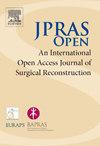日本基底细胞癌切除2mm手术缘的疗效:一步手术的回顾性研究。
IF 1.5
Q3 SURGERY
引用次数: 0
摘要
背景:基底细胞癌是最常见的皮肤恶性肿瘤。标准的治疗方法是手术切除预定的边缘。一些人认为目前推荐的手术切缘过大,如此宽的手术切缘是否适用于所有病变值得怀疑。我们统计调查了窄切缘的切除,并试图确定一步手术后复发的危险因素。方法:在日本的一个研究所进行了6年的基底细胞癌切除术,回顾性分析了病理报告和病例记录的复发率。我们回顾了切除标本的显微镜检查结果,并检查了切除边缘状态、肿瘤亚型和神经周围浸润情况。结果:48例基底细胞癌(45例原发,3例复发)被纳入本研究。在原发病变中,色素沉着、界限分明的病变未表现出任何累及手术边缘、神经周围浸润或局部复发的迹象。结论:在日本,2毫米的切缘可以安全切除色素沉着、界限分明的基底细胞癌原发灶。复发性病变可以在确认阴性切缘后通过窄切缘重建治疗,而不是进行普通的宽切缘切除。本文章由计算机程序翻译,如有差异,请以英文原文为准。
Outcome of basal cell carcinoma excision with 2 mm surgical margin in Japanese patients: A retrospective study of one-step surgery
Background
Basal cell carcinoma is the most common skin malignancy. The standard treatment is surgical excision with predetermined margins. Some argue that the currently recommended surgical margins are excessive, and it is questionable whether such wide surgical margins should be applied to all lesions. We statistically investigated excisions with narrow margins and tried to identify the risk factors for recurrence after one-step surgery.
Methods
Basal cell carcinomas were excised at a single institute in Japan over a six-year period and the recurrence rates were retrospectively analyzed using pathological reports and case notes. We reviewed the microscopic findings of the excised specimens and examined the excisional margin status, tumor subtype, and perineural invasion.
Results
Forty-eight basal cell carcinomas (45 primary and 3 recurrent) that were identified in Japanese patients were included in this study. Among the primary lesions, well-pigmented and well-defined lesions did not show any involvement of the surgical margins, perineural invasion, or development of local recurrence. Recurrent lesions were significantly associated with positive surgical margins (side margin, P<0.01; deep margin, P<0.01) during the primary operation; however, no association was found with local recurrence after re-resection. Significant differences were observed in perineural invasion and the tumor subtype, especially in the aggressive subtype (P<0.05).
Conclusions
A 2 mm margin allows for the safe excision of primary lesions with well-pigmented and well-defined basal cell carcinoma in Japan. Recurrent lesions can be treated with narrow margins by reconstruction after confirmation of a negative margin, instead of performing a common resection with wide margins.
求助全文
通过发布文献求助,成功后即可免费获取论文全文。
去求助
来源期刊

JPRAS Open
Medicine-Surgery
CiteScore
1.60
自引率
0.00%
发文量
89
审稿时长
22 weeks
期刊介绍:
JPRAS Open is an international, open access journal dedicated to publishing case reports, short communications, and full-length articles. JPRAS Open will provide the most current source of information and references in plastic, reconstructive & aesthetic surgery. The Journal is based on the continued need to improve surgical care by providing highlights in general reconstructive surgery; cleft lip, palate and craniofacial surgery; head and neck surgery; skin cancer; breast surgery; hand surgery; lower limb trauma; burns; and aesthetic surgery. The Journal will provide authors with fast publication times.
 求助内容:
求助内容: 应助结果提醒方式:
应助结果提醒方式:


